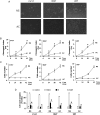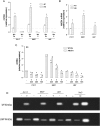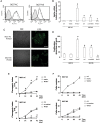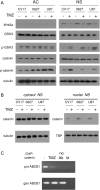Temozolomide downregulates P-glycoprotein expression in glioblastoma stem cells by interfering with the Wnt3a/glycogen synthase-3 kinase/β-catenin pathway
- PMID: 23897632
- PMCID: PMC3813413
- DOI: 10.1093/neuonc/not104
Temozolomide downregulates P-glycoprotein expression in glioblastoma stem cells by interfering with the Wnt3a/glycogen synthase-3 kinase/β-catenin pathway
Abstract
Background: Glioblastoma multiforme stem cells display a highly chemoresistant phenotype, whose molecular basis is poorly known. We aim to clarify this issue and to investigate the effects of temozolomide on chemoresistant stem cells.
Methods: A panel of human glioblastoma cultures, grown as stem cells (neurospheres) and adherent cells, was used.
Results: Neurospheres had a multidrug resistant phenotype compared with adherent cells. Such chemoresistance was overcome by apparently noncytotoxic doses of temozolomide, which chemosensitized glioblastoma cells to doxorubicin, vinblastine, and etoposide. This effect was selective for P-glycoprotein (Pgp) substrates and for stem cells, leading to an investigation of whether there was a correlation between the expression of Pgp and the activity of typical stemness pathways. We found that Wnt3a and ABCB1, which encodes for Pgp, were both highly expressed in glioblastoma stem cells and reduced by temozolomide. Temozolomide-treated cells had increased methylation of the cytosine-phosphate-guanine islands in the Wnt3a gene promoter, decreased expression of Wnt3a, disrupted glycogen synthase-3 kinase/β-catenin axis, reduced transcriptional activation of ABCB1, and a lower amount and activity of Pgp. Wnt3a overexpression was sufficient to transform adherent cells into neurospheres and to simultaneously increase proliferation and ABCB1 expression. On the contrary, glioblastoma stem cells silenced for Wnt3a lost the ability to form neurospheres and reduced at the same time the proliferation rate and ABCB1 levels.
Conclusions: Our work suggests that Wnt3a is an autocrine mediator of stemness, proliferation, and chemoresistance in human glioblastoma and that temozolomide may chemosensitize the stem cell population by downregulating Wnt3a signaling.
Keywords: ABCB1/P-glycoprotein; Wnt3a; glioblastoma stem cells; temozolomide.
Figures








Similar articles
-
Temozolomide down-regulates P-glycoprotein in human blood-brain barrier cells by disrupting Wnt3 signaling.Cell Mol Life Sci. 2014 Feb;71(3):499-516. doi: 10.1007/s00018-013-1397-y. Epub 2013 Jun 15. Cell Mol Life Sci. 2014. PMID: 23771630 Free PMC article.
-
A MDR1 (ABCB1) gene single nucleotide polymorphism predicts outcome of temozolomide treatment in glioblastoma patients.Ann Oncol. 2009 Jan;20(1):175-81. doi: 10.1093/annonc/mdn548. Epub 2008 Aug 7. Ann Oncol. 2009. PMID: 18687982
-
miR-126-3p sensitizes glioblastoma cells to temozolomide by inactivating Wnt/β-catenin signaling via targeting SOX2.Life Sci. 2019 Jun 1;226:98-106. doi: 10.1016/j.lfs.2019.04.023. Epub 2019 Apr 10. Life Sci. 2019. PMID: 30980849
-
Chemoresistance of glioblastoma cancer stem cells--much more complex than expected.Mol Cancer. 2011 Oct 11;10:128. doi: 10.1186/1476-4598-10-128. Mol Cancer. 2011. PMID: 21988793 Free PMC article. Review.
-
Molecular mechanisms of temozolomide resistance in glioblastoma multiforme.Expert Rev Anticancer Ther. 2012 May;12(5):635-42. doi: 10.1586/era.12.37. Expert Rev Anticancer Ther. 2012. PMID: 22594898 Review.
Cited by
-
Overcoming drug resistance in glioblastoma: new options in sight?Cancer Drug Resist. 2021 Jun 19;4(2):512-516. doi: 10.20517/cdr.2021.03. eCollection 2021. Cancer Drug Resist. 2021. PMID: 35582029 Free PMC article. No abstract available.
-
Temozolomide promotes glioblastoma stemness expression through senescence-associated reprogramming via HIF1α/HIF2α regulation.Cell Death Dis. 2025 Apr 19;16(1):317. doi: 10.1038/s41419-025-07617-w. Cell Death Dis. 2025. PMID: 40253386 Free PMC article.
-
Targeting BC200/miR218-5p Signaling Axis for Overcoming Temozolomide Resistance and Suppressing Glioma Stemness.Cells. 2020 Aug 8;9(8):1859. doi: 10.3390/cells9081859. Cells. 2020. PMID: 32784466 Free PMC article.
-
The histone demethylase KDM5A is a key factor for the resistance to temozolomide in glioblastoma.Cell Cycle. 2015;14(21):3418-29. doi: 10.1080/15384101.2015.1090063. Cell Cycle. 2015. PMID: 26566863 Free PMC article.
-
Glycogenolysis in Acquired Glioma Resistance to Temozolomide: A Role for the [Ca2+]i-dependent Activation of Na,K-ATPase/ERK1/2 Signaling.Front Pharmacol. 2018 Aug 7;9:873. doi: 10.3389/fphar.2018.00873. eCollection 2018. Front Pharmacol. 2018. PMID: 30131700 Free PMC article.
References
Publication types
MeSH terms
Substances
LinkOut - more resources
Full Text Sources
Other Literature Sources
Medical
Miscellaneous

